ChatGPT:
The Giant’s Causeway is a spectacular natural formation located on the northeast coast of Northern Ireland, near the town of Bushmills in County Antrim. This UNESCO World Heritage Site is renowned for its approximately 40,000 interlocking basalt columns, most of which have a hexagonal shape. The columns form stepping stones that lead from the foot of the cliffs into the sea, creating a unique and striking landscape.
Formation Process:
The Giant’s Causeway was formed around 50 to 60 million years ago during the Paleogene Period, a time of significant volcanic activity in the region. Here’s how the phenomenon occurred:
1. Volcanic Eruptions: Molten basaltic lava erupted through fissures in the Earth’s crust, spreading out in extensive lava flows over the existing chalk bedrock.
2. Cooling and Contraction: As the thick lava flows cooled slowly, they began to contract. This contraction happened both vertically and horizontally.
3. Fracturing: The horizontal contraction led to the formation of tensile stress within the solidifying rock. To relieve this stress, the rock fractured in a pattern of polygonal cracks, similar to how drying mud can crack in hexagonal shapes.
4. Column Formation: These fractures propagated down through the cooling lava flow, resulting in the formation of elongated, prismatic columns. While hexagons are the most common shape due to their efficiency in filling space, columns with anywhere from four to eight sides can be found.
5. Erosion Exposure: Over millions of years, natural erosion by the sea and weather exposed these basalt columns, revealing the extensive “causeway” that we see today.
Additional Information:
• Geological Significance: The uniformity and regularity of the columns make the Giant’s Causeway a prime example of columnar jointing in basalt. This phenomenon provides valuable insights into the cooling and solidification processes of volcanic rocks.
• Cultural Lore: The site is steeped in local legend. According to Irish mythology, the giant Finn McCool built the causeway to walk to Scotland to confront his rival, the giant Benandonner. Variations of the tale explain the presence of similar basalt columns on the Scottish isle of Staffa.
• Biodiversity: The area is also notable for its rich biodiversity, including unique flora and fauna that have adapted to the rugged coastal environment.
The Giant’s Causeway stands as a testament to the powerful geological forces that have shaped our planet. Its striking appearance and the fascinating natural processes behind its formation continue to captivate scientists and visitors alike.
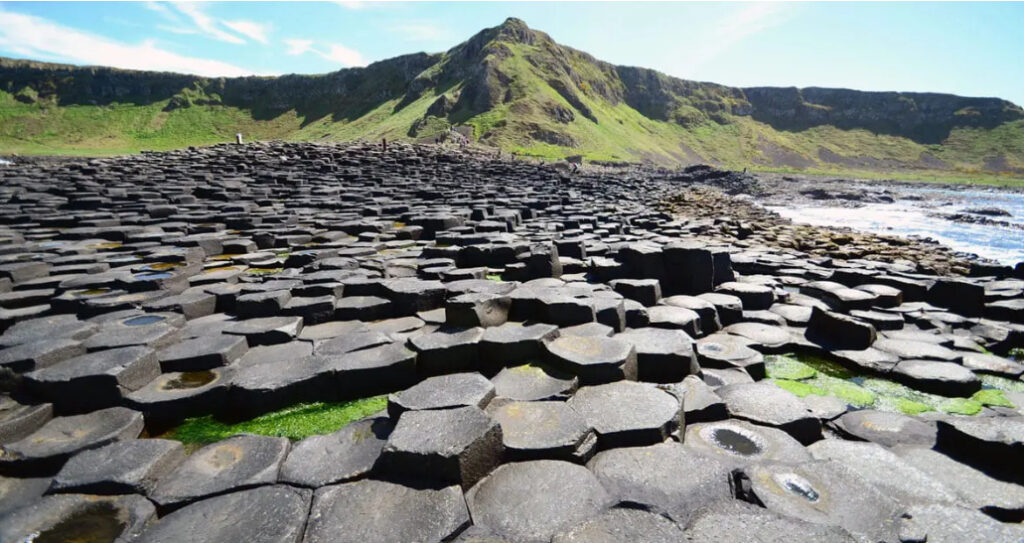
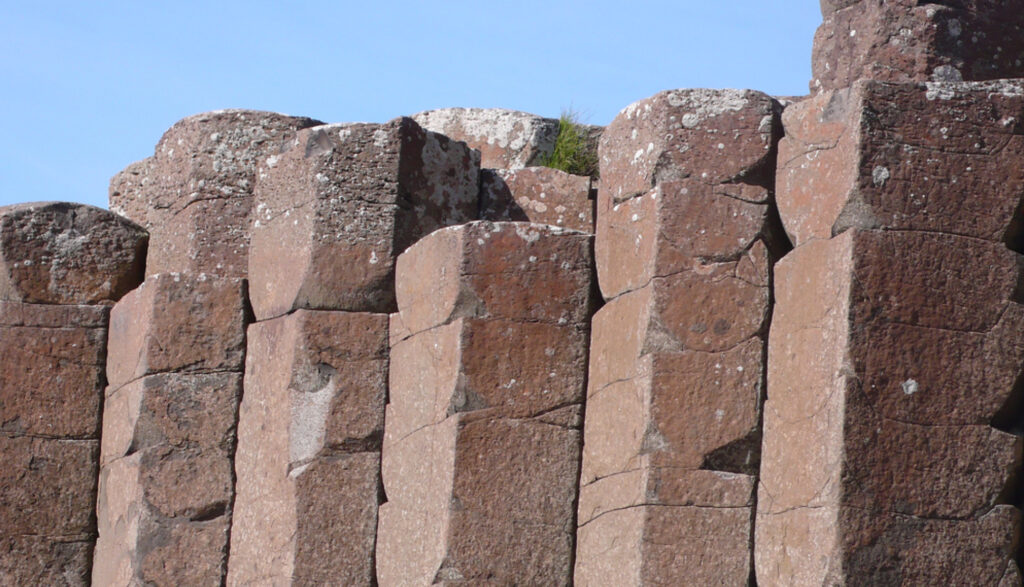
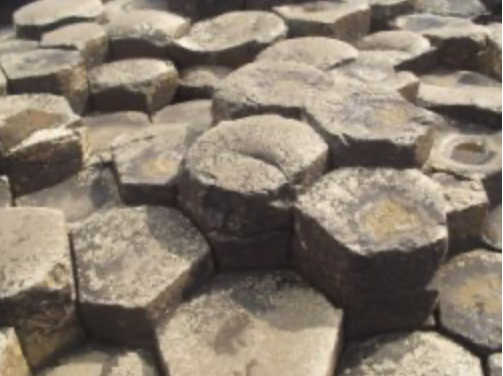
Myths and Legends Associated with the Giant’s Causeway
The Giant’s Causeway is not only a geological marvel but also a place rich in folklore and mythology. The most renowned legend associated with this natural wonder involves the Irish giant Fionn mac Cumhaill (pronounced “Finn McCool”) and his Scottish rival, Benandonner. This tale has been passed down through generations, adding a layer of enchantment to the site’s striking basalt columns.
The Legend of Fionn mac Cumhaill and Benandonner
• The Rivalry Begins: Fionn mac Cumhaill was a legendary Irish giant known for his strength and bravery. Across the Irish Sea, on the Scottish coast, lived another giant named Benandonner. The two giants were rivals, often taunting each other from afar and eager to prove who was the mightier.
• Building the Causeway: Determined to confront Benandonner, Fionn decided to build a massive stone causeway across the sea. Using his immense strength, he lifted and placed giant rocks into the water, creating a bridge that stretched from Ireland to Scotland. This is the mythical explanation for the interlocking basalt columns of the Giant’s Causeway.
• A Change of Heart: As Fionn neared Scotland or when Benandonner was approaching Ireland (versions vary), Fionn realized that Benandonner was significantly larger and more formidable than he had anticipated. Fearful of the impending confrontation, Fionn retreated to his home.
• The Clever Disguise: Fionn’s wife, Oonagh (or sometimes “Oona”), devised a cunning plan to protect her husband. She dressed Fionn in baby clothes and laid him in a giant cradle, disguising him as their infant son.
• Benandonner’s Arrival: When Benandonner arrived at Fionn’s residence seeking his rival, Oonagh welcomed him and explained that Fionn was not home. She invited Benandonner inside and introduced him to their “baby.”
• The Intimidated Opponent: Upon seeing the enormous size of the “child,” Benandonner was astonished. He thought that if the baby was this large, the father must be gigantic beyond measure. Overcome with fear, Benandonner hastily fled back to Scotland.
• Destruction of the Causeway: In his panic, Benandonner tore up the causeway behind him to prevent Fionn from following him. This act left only the remnants of the causeway on both sides of the sea—the Giant’s Causeway in Ireland and similar basalt formations on the Scottish Isle of Staffa.
Other Folklore and Mythological Connections
• Fingal’s Cave: The Isle of Staffa in Scotland features a sea cave known as Fingal’s Cave, which has the same hexagonal basalt columns as the Giant’s Causeway. The name “Fingal” is derived from the Gaelic name “Fionn Gall,” linking it back to Fionn mac Cumhaill. This connection reinforces the legend that the causeway once spanned between Ireland and Scotland.
• The Giant’s Boot and Other Rock Formations: Various rock formations around the Giant’s Causeway have inspired local legends:
• The Giant’s Boot: A large, boot-shaped rock is said to have been lost by Fionn as he fled from Benandonner.
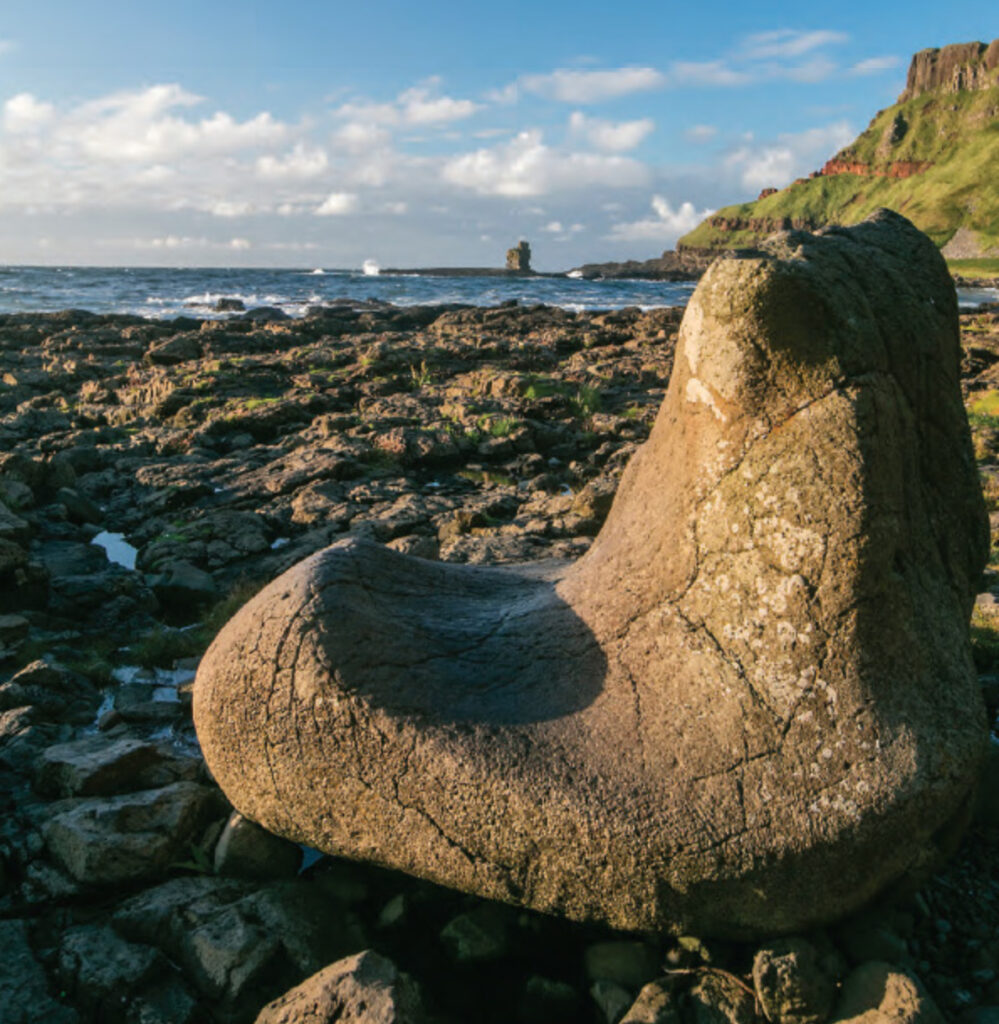
• The Wishing Chair: A natural throne formed by the basalt columns, believed to grant wishes to those who sit upon it.
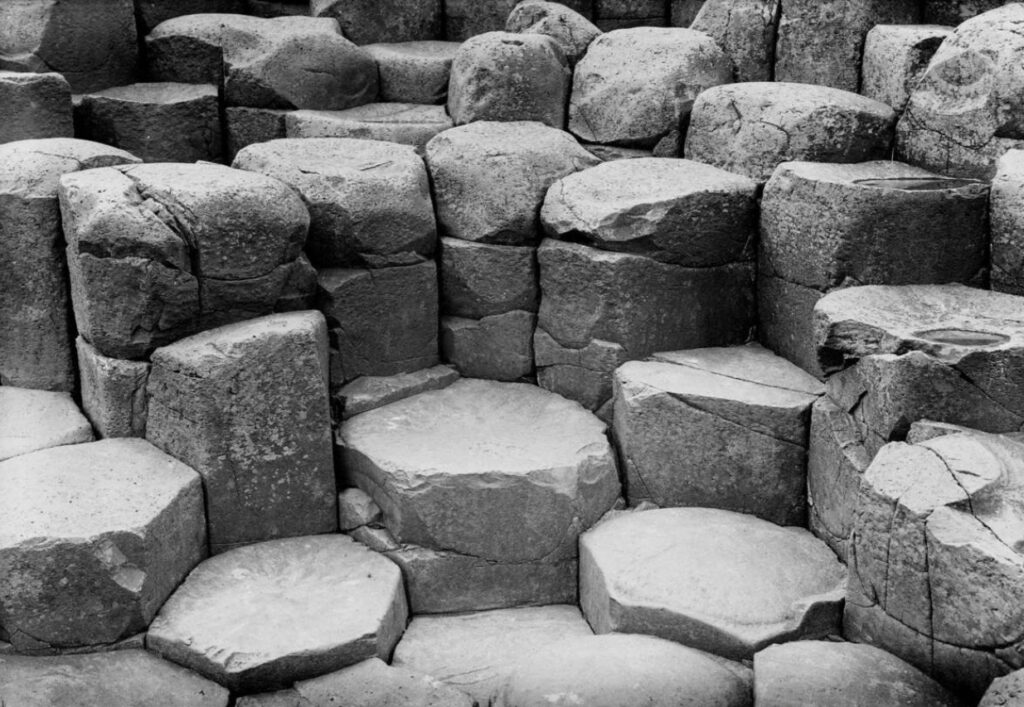
• The Organ: Columns resembling organ pipes are thought to be the instrument Fionn played.
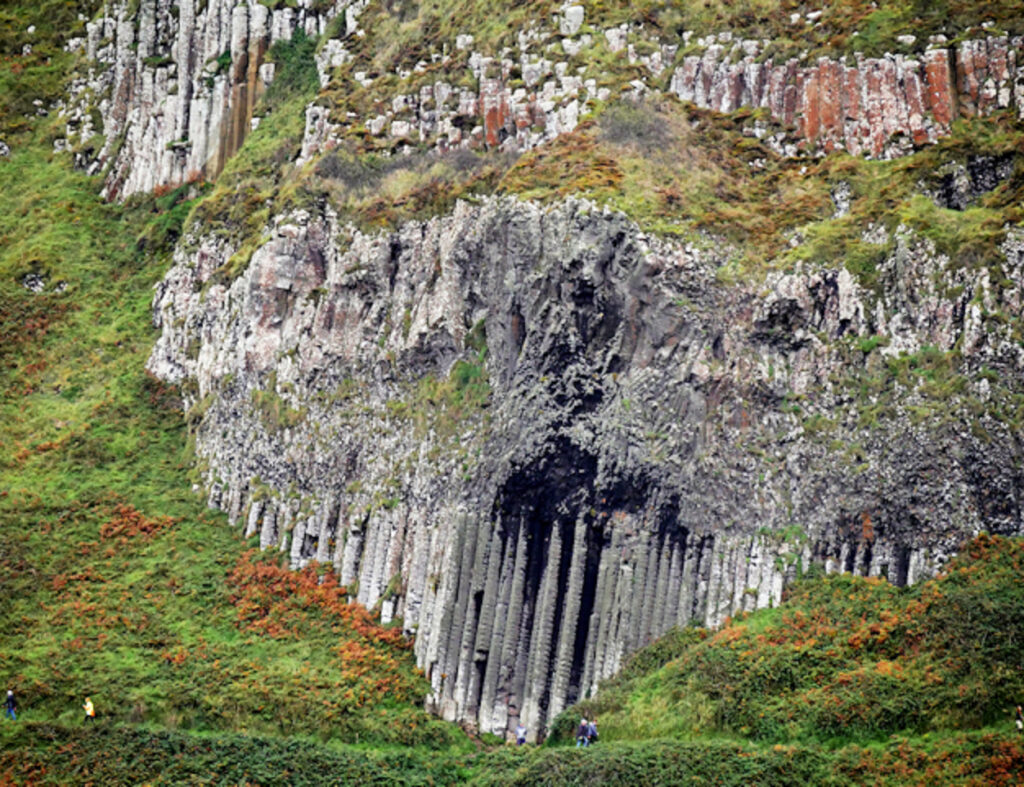
• Giant Lore in Celtic Mythology: Giants play a significant role in Irish and Scottish folklore, often symbolizing natural forces and the shaping of the landscape. The stories of Fionn mac Cumhaill extend beyond the Giant’s Causeway, depicting him as a hero and leader of the Fianna, a band of warriors in Irish mythology.
Cultural Significance
• Oral Tradition: The legend of the Giant’s Causeway has been preserved through centuries of oral storytelling, contributing to Ireland’s rich cultural heritage.
• Symbolism: The tale embodies themes of ingenuity over brute strength, showcasing how cleverness can triumph in the face of overwhelming odds.
• Influence on Art and Literature: The myths have inspired various artistic works, including literature, music, and visual arts. For instance, the composer Felix Mendelssohn was inspired by Fingal’s Cave to write the “Hebrides Overture,” capturing the mystical essence of the landscape.
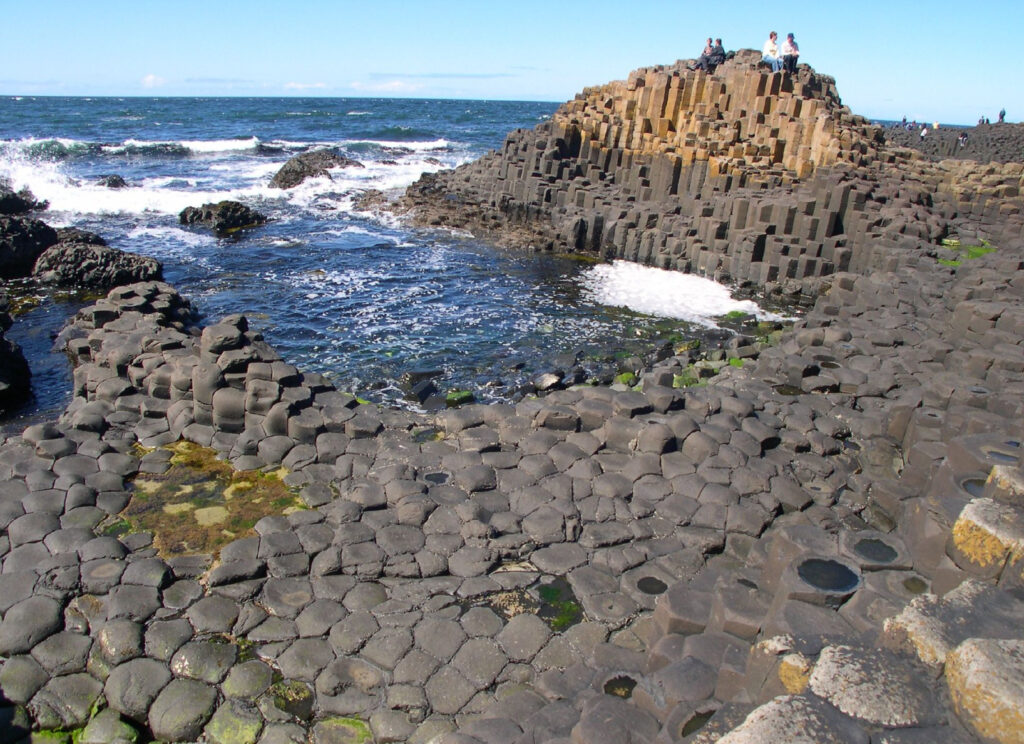
The area surrounding the Giant’s Causeway is rich with historical monuments and tourist attractions that you might find interesting. Here are some notable sites nearby:
1. Dunluce Castle:
Located just a few miles west of the Giant’s Causeway, Dunluce Castle is a dramatic medieval ruin perched on the edge of a cliff overlooking the North Atlantic Ocean. Dating back to the 13th century, the castle offers a glimpse into Northern Ireland’s tumultuous history and provides stunning coastal views.

2. Old Bushmills Distillery:
Situated in the nearby village of Bushmills, this is the oldest licensed whiskey distillery in the world, with a license dating back to 1608. Visitors can take guided tours to learn about traditional whiskey-making processes and enjoy tastings of their renowned Irish whiskey.
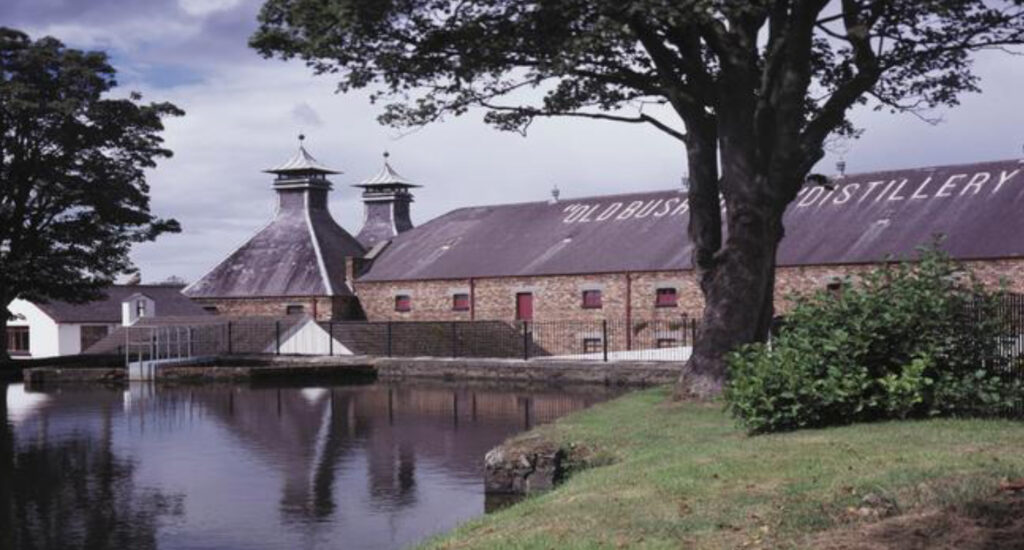
3. Carrick-a-Rede Rope Bridge:
About 7 miles east of the Giant’s Causeway, this famous rope bridge connects the mainland to the tiny island of Carrick-a-Rede. Originally constructed by salmon fishermen over 250 years ago, crossing the bridge offers thrilling views of the rugged coastline and clear waters below.
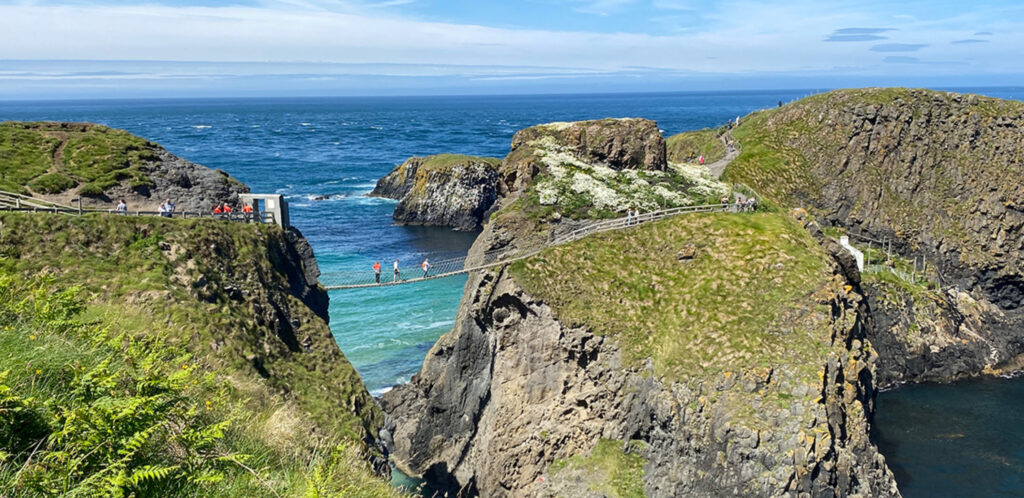
4. The Dark Hedges:
Located near the village of Armoy, approximately 13 miles from the Giant’s Causeway, the Dark Hedges is an enchanting avenue of beech trees planted in the 18th century. This natural tunnel has become a popular tourist spot, especially after featuring as the Kingsroad in the TV series Game of Thrones.
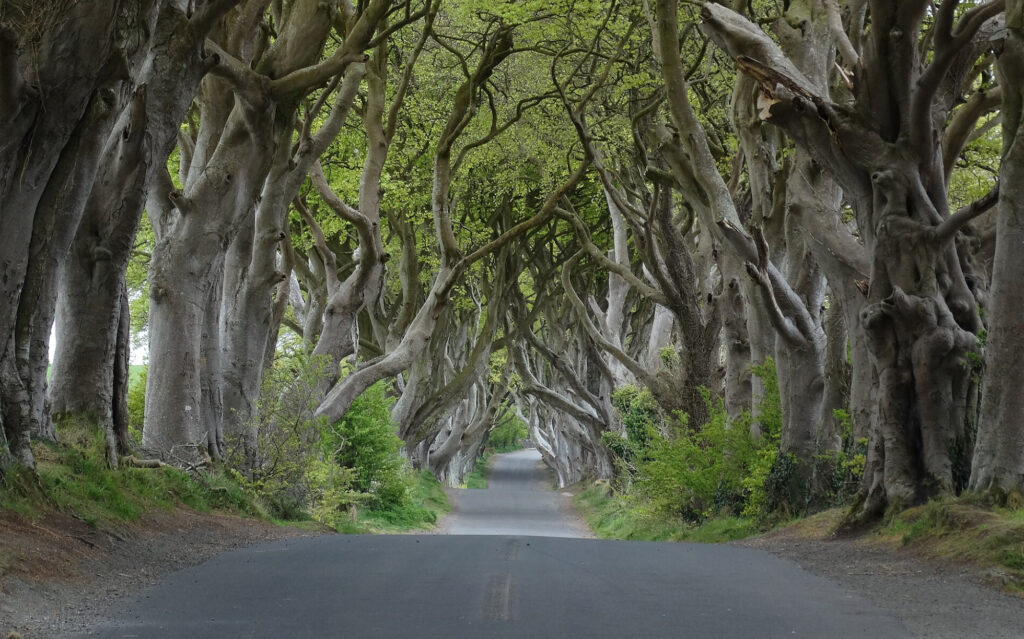
5. Ballintoy Harbour:
A picturesque harbor situated between the Giant’s Causeway and Carrick-a-Rede Rope Bridge. It’s known for its charming scenery and has also served as a filming location for Game of Thrones. The harbor is an excellent spot for photography and coastal walks.
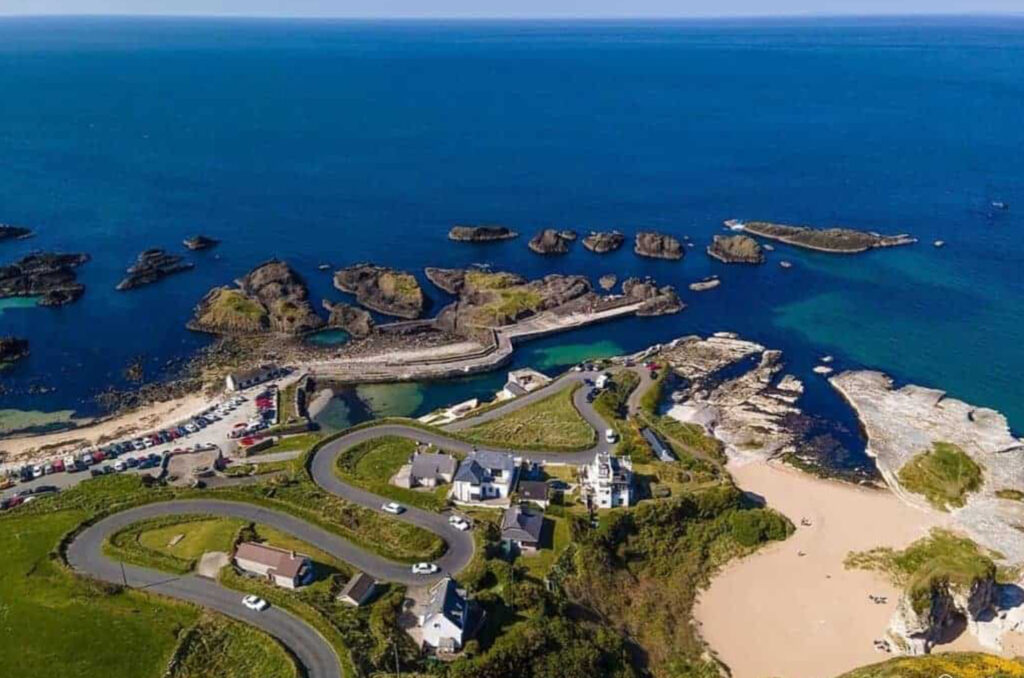
6. Mussenden Temple and Downhill Demesne:
Approximately 20 miles west of the Giant’s Causeway, Mussenden Temple is a small, circular building perched dramatically on a 120-foot cliff edge, offering panoramic views over Downhill Strand and the Atlantic Ocean. The surrounding Downhill Demesne includes the ruins of Downhill House and beautiful landscaped gardens.
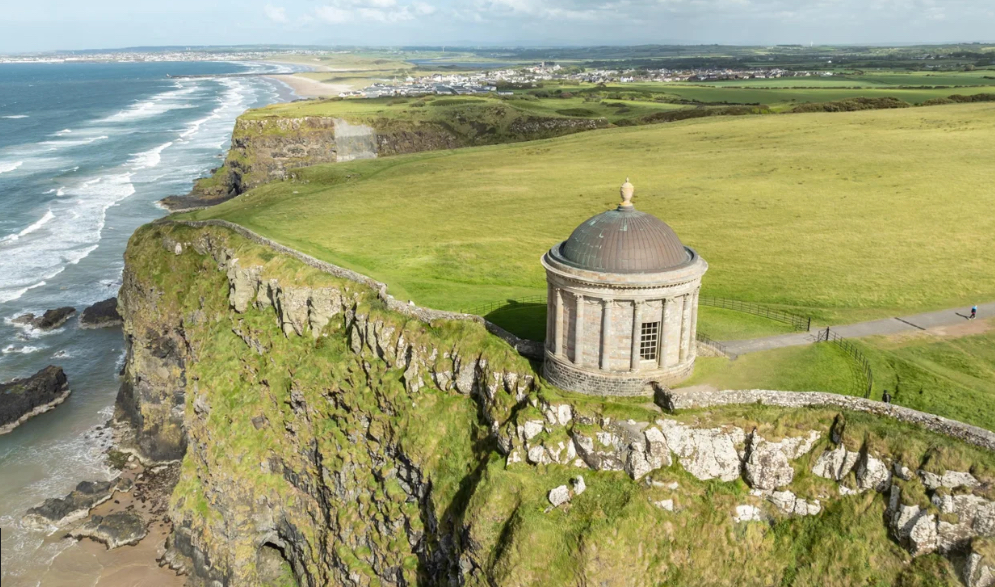
7. Rathlin Island:
Accessible by ferry from the town of Ballycastle, Rathlin Island is Northern Ireland’s only inhabited offshore island. It’s renowned for its rugged landscapes, bird sanctuaries—home to puffins and other seabirds—and historical sites like the Rathlin West Light, an “upside-down” lighthouse.
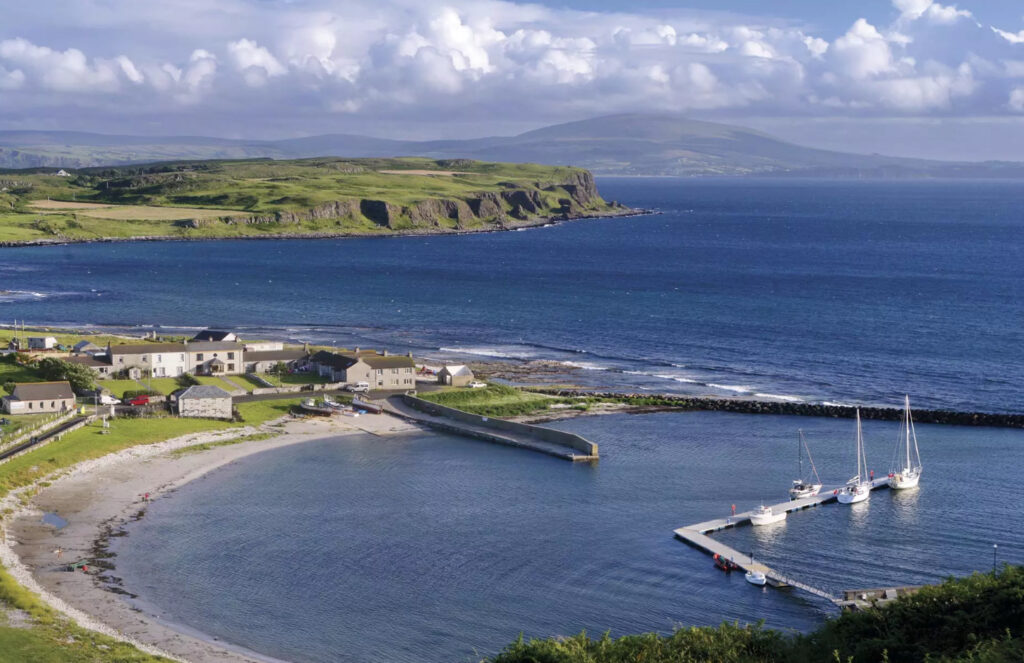
8. Portrush and Portstewart:
These neighboring seaside towns offer beautiful sandy beaches, surf spots, golf courses, and a variety of restaurants and entertainment options. Portrush is home to the Royal Portrush Golf Club, which has hosted The Open Championship, one of golf’s four major tournaments.
9. Kinbane Castle:
A lesser-known gem, Kinbane Castle is a 16th-century castle ruin situated on a white limestone headland jutting into the sea. The site offers spectacular views and a more secluded experience compared to some of the busier tourist spots.
10. Causeway Coastal Route:
This scenic driving route stretches along the coast between Belfast and Derry~Londonderry, passing through the Giant’s Causeway and other attractions. The route is celebrated for its breathtaking landscapes, including cliffs, beaches, glens, and charming villages.
These attractions offer a diverse mix of natural beauty, historical significance, and cultural experiences. Whether you’re interested in history, outdoor adventures, or simply enjoying stunning scenery, the area around the Giant’s Causeway has plenty to explore.
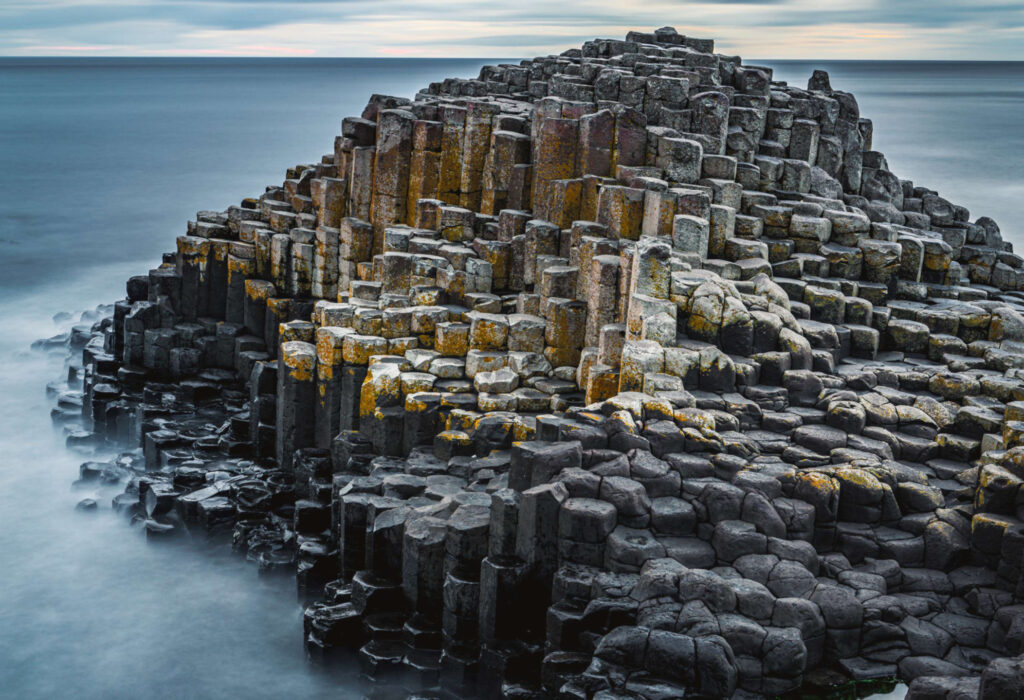
One-Day Itinerary for Visiting the Giant’s Causeway Area
Morning
8:30 AM – Start Your Day at the Giant’s Causeway
• Arrive Early: Begin your day at the Giant’s Causeway Visitor Centre to beat the crowds and enjoy the serene morning atmosphere.
• Explore the Causeway:
• Guided Audio Tour: Pick up an audio guide for insightful commentary as you walk.
• Stroll to the Stones: The walk from the visitor center to the stones is about 1 km (0.6 miles) along a paved road, suitable for an easy hike.
• Highlights: Visit iconic formations like the Wishing Chair, Giant’s Boot, and Organ Pipes.
• Optional Hiking:
• Clifftop Experience: For panoramic views, take the Red Trail, an easy-to-moderate 2-mile hike along the clifftops. It offers stunning vistas of the coastline and the Causeway below.
10:30 AM – Coffee Break at Causeway Hotel
• Local Treats: Stop by the Causeway Hotel, adjacent to the visitor center, for a cup of Irish coffee or tea and a freshly baked scone with jam and cream.
Late Morning
11:00 AM – Walk the Causeway Coast Way to Dunseverick Castle
• Easy Hiking:
• Trail Overview: Embark on a section of the Causeway Coast Way, a well-marked path offering easy hiking suitable for all fitness levels.
• Distance: The walk to Dunseverick Castle ruins is approximately 3 miles (4.8 km) and takes about 1.5 hours at a leisurely pace.
• Scenic Highlights:
• Birdwatching: Keep an eye out for seabirds like fulmars and kittiwakes.
• Landscape: Enjoy views of rugged cliffs, lush pastures, and the distant Scottish Isles on clear days.
Afternoon
12:30 PM – Picnic Lunch at Dunseverick Castle
• Historic Ruins: Explore the remnants of Dunseverick Castle, steeped in history dating back to the 5th century.
• Picnic Idea:
• Local Produce: Before leaving the Giant’s Causeway area, pick up a packed lunch or pre-arranged picnic basket featuring local specialties like Dulse (edible seaweed), Irish soda bread sandwiches, and Ballycastle smoked salmon.
• Setting: Enjoy your meal with a backdrop of the Atlantic Ocean and ancient ruins.
1:30 PM – Travel to Carrick-a-Rede Rope Bridge
• Transportation: Drive or take a taxi to the Carrick-a-Rede Rope Bridge, approximately a 15-minute drive east along the coast.
1:45 PM – Cross the Carrick-a-Rede Rope Bridge
• Adventure:
• The Bridge: Originally built by salmon fishermen, the rope bridge spans 20 meters (66 feet) and is suspended 30 meters (98 feet) above the sea.
• Easy Walk: A 1 km (0.6 miles) walk from the car park to the bridge along a well-maintained path.
• Explore Carrick-a-Rede Island:
• Views: Spectacular vistas of Rathlin Island and Scotland.
• Wildlife: Spot marine life like basking sharks and dolphins during the summer months.
Mid-Afternoon
3:00 PM – Visit Ballintoy Harbour
• Short Drive: Just 5 minutes from Carrick-a-Rede.
• Scenic Stop:
• Photography: Capture the picturesque harbor, famous as a filming location for Game of Thrones.
• Beach Walk: Take an easy stroll along the sandy beach and explore the rock pools.
3:45 PM – Afternoon Tea at Roark’s Kitchen
• Local Cafe: Situated at Ballintoy Harbour, Roark’s Kitchen is a charming spot offering homemade pastries, soups, and sandwiches.
• Treats to Try:
• Irish Stew: A hearty option if you’re feeling hungry.
• Bakewell Tart: A classic dessert to satisfy your sweet tooth.
Late Afternoon
4:30 PM – Explore Dunluce Castle
• Travel: Drive west for about 20 minutes to reach Dunluce Castle.
• Historical Exploration:
• Castle Ruins: Perched dramatically on the cliff edge, the castle dates back to the 13th century.
• Self-Guided Tour: Wander through the ruins and learn about its storied past, including tales of shipwrecks and sieges.
• Photo Opportunity: The late afternoon light is perfect for photography, with the castle silhouetted against the sea.
Evening
6:00 PM – Dinner in Portrush
• Travel: A short 10-minute drive from Dunluce Castle brings you to the seaside town of Portrush.
• Dining Options:
1. Ramore Restaurants:
• A collection of eateries offering a variety of cuisines.
• Local Specialties: Try the seafood chowder, Irish mussels, or fish and chips made with fresh Atlantic catch.
2. Harbour Bar:
• A traditional pub with a cozy atmosphere.
• Drinks: Enjoy a pint of locally brewed Hilden Brewery beer or a glass of Bushmills whiskey.
• Dessert: Don’t miss the famous Morelli’s Ice Cream Parlour for a scoop of traditional Irish ice cream.
7:30 PM – Sunset Stroll on East Strand Beach
• Relaxation:
• Beach Walk: Take an easy walk along East Strand Beach, enjoying the expansive sandy shoreline.
• Sunset Views: Watch the sun set over the Atlantic, a perfect way to conclude your day.
Additional Tips
• Transportation: Renting a car offers the most flexibility, but local tour companies provide guided options if preferred.
• Attire:
• Footwear: Wear comfortable walking shoes suitable for varied terrain.
• Clothing: Dress in layers and bring a waterproof jacket, as weather can be unpredictable.
• Reservations:
• Carrick-a-Rede Rope Bridge: It’s advisable to book tickets in advance, especially during peak season.
• Dining: Make dinner reservations to ensure seating, particularly at popular restaurants.
Local Food Specialties to Try
• Ulster Fry: A traditional Northern Irish breakfast featuring eggs, bacon, sausage, black pudding, soda bread, and potato bread.
• Irish Stew: A hearty stew made with lamb or mutton, potatoes, carrots, and onions.
• Colcannon: Mashed potatoes mixed with kale or cabbage, often served as a side dish.
• Dulse: Edible seaweed that can be eaten dried and is a popular local snack.
• Yellowman: A honeycomb toffee similar to cinder toffee, often found at local markets.
Enjoy your visit to the Giant’s Causeway area! This itinerary offers a blend of natural wonders, gentle hiking, historical exploration, and the delightful tastes of Northern Ireland. Safe travels and savor every moment of your adventure along the stunning Causeway Coast.

